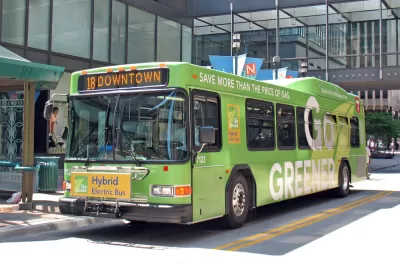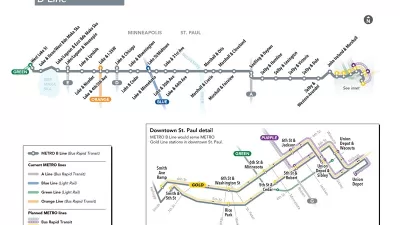The Twin Cities found the secret to bus service success, but it was never really a secret.

"The reviews are in for the Twin Cities’ first enhanced bus route — the A Line — and riders want more," according to an article by Angie Schmitt.
"Metro Transit calls the service arterial Bus Rapid Transit, or 'aBRT,' but the A Line has no dedicated right of way as it runs along Snelling Avenue," explains Schmitt. "Instead, the A Line has features that should be common on most bus routes."
That last point is the key to A Line's success in the Twin Cities. The kinds of service improvements Schmitt lists aren't innovations, invented by Elon Musk or someone at Sidewalk Labs. These are service improvements in place already all over the world, either in part or in total, that are proven to increase transit ridership. Whether transit is a real world priority or just a priority in press releases all depends on political leadership from politicians and planners.
The A Line has increased ridership by 30 percent since improvements were completed in 2016. That resounding success is clearing the way for more upgrades to other routes in the system. Schmitt provides more information:
Governor Mark Dayton has proposed $50 million in bonding for similar improvements to other bus routes. And the Pioneer Press gave this approach a resounding endorsement, saying the A Line is a good value that can be replicated quickly and help the region meet the needs of its growing population.
FULL STORY: Minneapolis Figured Out the Formula for Increasing Bus Ridership

Alabama: Trump Terminates Settlements for Black Communities Harmed By Raw Sewage
Trump deemed the landmark civil rights agreement “illegal DEI and environmental justice policy.”

Planetizen Federal Action Tracker
A weekly monitor of how Trump’s orders and actions are impacting planners and planning in America.

Why Should We Subsidize Public Transportation?
Many public transit agencies face financial stress due to rising costs, declining fare revenue, and declining subsidies. Transit advocates must provide a strong business case for increasing public transit funding.

Understanding Road Diets
An explainer from Momentum highlights the advantages of reducing vehicle lanes in favor of more bike, transit, and pedestrian infrastructure.

New California Law Regulates Warehouse Pollution
A new law tightens building and emissions regulations for large distribution warehouses to mitigate air pollution and traffic in surrounding communities.

Phoenix Announces Opening Date for Light Rail Extension
The South Central extension will connect South Phoenix to downtown and other major hubs starting on June 7.
Urban Design for Planners 1: Software Tools
This six-course series explores essential urban design concepts using open source software and equips planners with the tools they need to participate fully in the urban design process.
Planning for Universal Design
Learn the tools for implementing Universal Design in planning regulations.
Caltrans
Smith Gee Studio
Institute for Housing and Urban Development Studies (IHS)
City of Grandview
Harvard GSD Executive Education
Toledo-Lucas County Plan Commissions
Salt Lake City
NYU Wagner Graduate School of Public Service





























